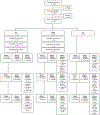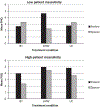Couple-focused interventions for men with localized prostate cancer and their spouses: A randomized clinical trial
- PMID: 30852854
- PMCID: PMC8279429
- DOI: 10.1111/bjhp.12359
Couple-focused interventions for men with localized prostate cancer and their spouses: A randomized clinical trial
Abstract
Objectives: Few couple-focused interventions have improved psychological and relationship functioning among men diagnosed with localized prostate cancer and their spouses. This study compared the impact of intimacy-enhancing therapy (IET), a general health and wellness intervention (GHW), and usual care (UC) on the psychological and relationship functioning of localized prostate cancer patients and their partners. Relationship length, relationship satisfaction, and patient masculinity were evaluated as moderators.
Design: This study was a randomized clinical trial with three study arms and four assessment time points.
Methods: A total of 237 patients and partners were randomly assigned to receive IET, GHW, or UC. Participants completed measures of psychological functioning and relationship satisfaction at baseline, 5 weeks, 3 months, and 6 months post-baseline. Primary outcomes were psychological adjustment, depression, cancer-specific distress, cancer concerns, and relationship satisfaction.
Results: Spouses in IET showed greater increases in relationship satisfaction than spouses in GHW and UC between the baseline and 5-week follow-up. Among patients in longer relationships, significant increases in psychological adjustment were found in both treatments compared to UC. Among spouses in longer relationships, psychological adjustment increased in both IET and UC but declined in GHW.
Conclusions: Intimacy-enhancing therapy did not show an impact on general or cancer-specific distress, but did show an early impact on relationship satisfaction among spouses. IET was superior to UC for patients in longer relationships. It will be important for researchers to understand which couple-focused interventions benefits both patients and spouses and to identify characteristics of patients, partners, and couples who may not benefit from psychological treatments. Statement of contribution What is already known on this subject? Men diagnosed with localized prostate cancer report lower health-related quality of life and both patients and spouses report elevated distress. Relationship communication plays a role in couples' psychological adaptation to prostate cancer. Couple-focused interventions have illustrated an impact on relationship communication. There are no studies comparing different couple-focused interventions. What does this study add? Intimacy-enhancing therapy was not superior to no treatment or a comparison treatment for the broad range of psychological and relationship outcomes. Intimacy-enhancing therapy was superior to no treatment for patients in longer-term relationship. The general health and wellness intervention was not beneficial for men in shorter relationships and for men who did not endorse traditional masculine norms.
Keywords: couples’ therapy; general health and wellness intervention; intimacy-enhancing therapy; prostate cancer; psychological intervention.
© 2019 The British Psychological Society.
Conflict of interest statement
Conflict of interest
All authors declare no conflict of interest.
Figures




Similar articles
-
Intimacy-enhancing psychological intervention for men diagnosed with prostate cancer and their partners: a pilot study.J Sex Med. 2011 Apr;8(4):1197-209. doi: 10.1111/j.1743-6109.2010.02163.x. Epub 2011 Jan 6. J Sex Med. 2011. PMID: 21210958 Free PMC article. Clinical Trial.
-
Relationship intimacy processes during treatment for couple-focused interventions for prostate cancer patients and their spouses.J Psychosoc Oncol Res Pract. 2019 Sep;1(2):e7. doi: 10.1097/OR9.0000000000000007. Epub 2019 Sep 20. J Psychosoc Oncol Res Pract. 2019. PMID: 36237825 Free PMC article.
-
Communication and intimacy-enhancing interventions for men diagnosed with prostate cancer and their partners.J Sex Med. 2013 Feb;10 Suppl 1(0 1):127-32. doi: 10.1111/jsm.12049. J Sex Med. 2013. PMID: 23387918 Free PMC article. Review.
-
Holding back, intimacy, and psychological and relationship outcomes among couples coping with prostate cancer.J Fam Psychol. 2015 Oct;29(5):708-19. doi: 10.1037/fam0000096. Epub 2015 Jul 20. J Fam Psychol. 2015. PMID: 26192132 Free PMC article.
-
Uptake and attrition in couple-based interventions for cancer: perspectives from the literature.Psychooncology. 2013 Dec;22(12):2639-47. doi: 10.1002/pon.3342. Epub 2013 Jul 10. Psychooncology. 2013. PMID: 23840033 Review.
Cited by
-
Associations of role, area deprivation index, and race with health behaviors and body mass index among localized prostate cancer patients and their partners.J Cancer Surviv. 2024 Jun 18. doi: 10.1007/s11764-024-01625-z. Online ahead of print. J Cancer Surviv. 2024. PMID: 38888710
-
Female partner experiences of prostate cancer patients' engagement with a community-based football intervention: a qualitative study.BMC Public Health. 2021 Jul 15;21(1):1398. doi: 10.1186/s12889-021-11448-7. BMC Public Health. 2021. PMID: 34266389 Free PMC article.
-
A systematic scoping review of post-treatment lifestyle interventions for adult cancer survivors and family members.J Cancer Surviv. 2022 Apr;16(2):233-256. doi: 10.1007/s11764-021-01013-x. Epub 2021 Mar 13. J Cancer Surviv. 2022. PMID: 33713302 Free PMC article.
-
A Systematic Review of Dietary Interventions for Cancer Survivors and Their Families or Caregivers.Nutrients. 2023 Dec 23;16(1):56. doi: 10.3390/nu16010056. Nutrients. 2023. PMID: 38201886 Free PMC article.
-
The effectiveness of psychological intervention for depression, anxiety, and distress in prostate cancer: a systematic review of literature.Prostate Cancer Prostatic Dis. 2021 Sep;24(3):674-687. doi: 10.1038/s41391-021-00342-3. Epub 2021 Mar 9. Prostate Cancer Prostatic Dis. 2021. PMID: 33750905
References
-
- American Institute for Cancer Research. (2017). Retrieved from http://www.aicr.org. Accessed July 28, 2017.
-
- Borkovec TD, & Nau SD (1972). Credibility of analogue therapy rationales. Journal of Behavioral Therapy and Experimental Psychiatry, 3, 117–126. 10.1016/0005-7916(72)90045-6 - DOI

